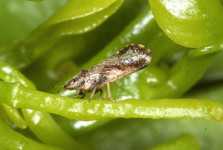California Industry Leaders Discuss Status Of Psyllid

In late August, California Assembly member Jim Patterson, who represents the Fresno area, hosted a “Citrus Industry Town Hall” at the Fresno County Farm Bureau offices for an update on the Asian citrus psyllid (ACP), and the steps being taken to control its spread in the state. Speakers included Joel Nelsen, president of California Citrus Mutual; Sylvie Robillard, Fresno Country regional grower liaison for the Citrus Pest & Disease Prevention Program (CPDPP), a statewide collaboration of agriculture officials and citrus industry representatives; and Beth Grafton-Cardwell, a University of California Cooperative Extension entomologist who’s worked with citrus growers in the San Joaquin Valley for 23 years. The following is a sampling of their remarks.
Joel Nelsen
“This is not complicated, ladies and gentlemen, but it is serious, very serious,” Nelsen began.
• He stressed that the ACP, followed by Huanglongbing (HLB), has marched across Florida, Texas, and Mexico, and has yet to be stopped. Though Mexico has not formally announced HLB, Nelsen said “They’re in a death spiral; they just don’t know it yet.” Of California’s efforts to hold off HLB: “We’re trying to do something that hasn’t been done,” he said, adding that the industry is trying to “achieve a victory that has been elusive in the rest of the world. We have to find Huanglongbing before it finds us.”
• All Californians have a stake in this battle, as there are citrus trees in most California backyards, which are home to more trees than are found in all the commercial groves. Actually, all Americans should be rooting for California, as it produces 85% of the nation’s fresh citrus, especially oranges and lemons. The San Joaquin Valley’s economy is particularly vulnerable, as it is home to 85 of the state’s 100 citrus packinghouses.
• There is a $25 million program in place. Of that, growers are providing $15 million, and they got more support from the federal government, which supplied the remaining $10 million, because federal officials witnessed the devastation that occurred in Florida.
• Nelsen says his job is to ensure that all the various parts of the program, from educating homeowners to lobbying legislators, are moving in the same direction. He and his board members meet with California Department of Food and Agriculture (CDFA) representatives at least once a month to evaluate how the program is going. It is a constant battle to slow the ACP and keep HLB out until a cure for HLB can be found. “What we are doing is unprecedented,” he concluded.
Sylvie Robillard
Detailing what steps are taken when there is an ACP find in a commercial grove, Robillard says she calls every grower who has trees within 800 meters, and then she calls Grafton-Cardwell, who develops the treatment protocol. The treatment protocol depends on many factors, such as the time of year. For example, a find in the fall would be treated very differently than a find in the summer.
The grower would then be called back and told to
treat with a broad spectrum chemical, preferably a
pyrethroid. She does not dictate precisely what chemicals to use. “You have a lot of leeway within the treatment
protocols,” she emphasized.
The grower also then names a point person on the farm for the find. “It’s up to you how you want to proceed,” she said. “We can deal with either you or your PCA.”
Beth Grafton-Cardwell
Outlining the general strategy to save the state’s citrus, Grafton-Cardwell said there were three goals regarding ACP: 1) Slow the spread to new areas; 2) Prevent ACP from finding HLB-infected trees; 3) If ACP does find an infected tree, slow the spread of HLB by reducing the ACP population. She noted that people are always asking her about eradication of ACP. “I don’t think we can eradicate it from the state,” she said, “but we can work on eradication from localized areas.”
• For those growers wondering why they might have to spray twice after an ACP find, Grafton-Cardwell said no insecticide gets them all. “It’s a strategy used around the world,” she said. “You sort of give the psyllid population a one-two punch.”
• Growers should always be thinking about ACP throughout the season, and using materials accordingly. For example, if an answer to thrips is needed, instead of using a chemical that just controls thrips, use one that controls both thrips and ACP. This has been an effective program in Florida, she noted.
• Growers cannot simply rely on traps. At certain times of the year, ACP prefers citrus trees to
traps, especially during periods of flush. “That’s why tap sampling is so important,” she said.
• Because of the limited range of the chemicals available to them, organic growers have to be particularly aggressive when dealing with ACP. Though when you get right down to it, “aggressive” is the key word for all growers in dealing with the pest. “The lower we drop those populations,” she said, “the more time we buy.”
• Researchers need that time to develop an answer, such as a cure for HLB. The industry cannot just keep spraying pesticides, or resistance problems will emerge. “We don’t want to be like Florida where they treat 12 times a year,” she said.
A Familiar Face
Second-generation citrus grower Kevin Severns will soon be appearing in televised public service announcements (PSAs) to inform people about the Asian citrus psyllid (ACP) and the deadly disease it can vector, Huanglongbing (HLB). The PSAs are intended to educate the general public about why they too should be concerned about ACP/HLB. More citrus trees in California are found in people’s yards than are found in all the commercial groves put together. There are three versions of the PSAs, 20, 30, and 60 seconds, and they will appear in both English and Spanish. In addition to being a citrus grower, Severns is the general manager of the Orange Cove-Sanger Citrus Association.









